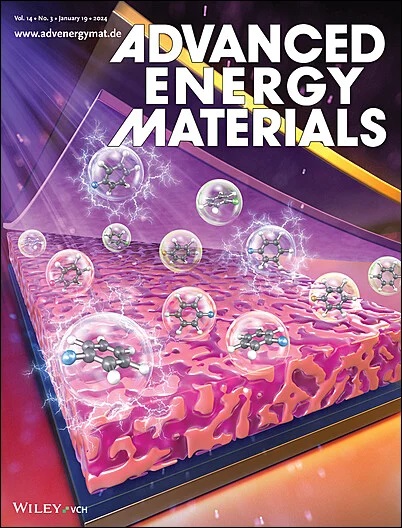A Novel Ti12-Based Metal-Organic Framework for Photocatalytic Hydrogen Evolution
IF 24.4
1区 材料科学
Q1 CHEMISTRY, PHYSICAL
引用次数: 0
Abstract
A new microporous titanium-based metal-organic framework (Ti-MOF), labeled as MIP-209(Ti) (MIP: Materials from Institute of Porous Materials of Paris), features nitro terephthalate ligands and Ti12O15 oxo-clusters, as revealed by continuous rotation electron diffraction (cRED). MIP-209(Ti) can be obtained using two different terephthalate (1, 4-BDC2−) derivatives such as NO2-BDC and 2Cl-BDC in an eco-friendly solvent, suggesting the isostructural versatility of Ti12-MOFs. Alternatively, its Ti-oxo-cluster can be tuned, similarly to MIP-177(Ti)-LT bearing the same Ti12O15 sub-unit. Typically, low percentage Cr3+ doping (≤5 at%) in MIP-209(Ti) favorably enhances the water stability. MIP-209(Ti-Cr)-NO2 shows a significant hydrogen production rate, with good reusability and stability under simulated solar light irradiation. Compared to the benchmark Ti-MOF IEF-11, the hydrogen production of MIP-209(Ti-Cr)-NO2 with 5 at% Cr doping has a fourfold enhancement in photocatalytic hydrogen evolution from water splitting reaction (HER) during 5 h in presence of methanol (5 812 µmol/gcat against 1 391 µmol/gcat), as well as, without any noble metal co-catalyst, a sixfold enhancement in overall water splitting reaction (OWS) (681 and 325 µmol/gcat of H2 and O2, respectively, against 94 and 53 µmol/gcat of H2 and O2, respectively). This work represents a leap forward in the synthesis of Ti-MOFs and their practical photocatalytic applications.

光催化析氢的新型ti12基金属有机骨架
连续旋转电子衍射(cRED)显示,一种新的微孔钛基金属有机骨架(Ti- mof),标记为MIP-209(Ti) (MIP: Materials from Institute of Porous Materials of Paris),具有对苯二甲酸硝基配体和Ti12O15氧簇。MIP-209(Ti)可以用两种不同的对苯二甲酸酯(1,4 - bdc2 -)衍生物NO2-BDC和2Cl-BDC在环保溶剂中得到,这表明ti12 - mof具有同位结构的通用性。或者,它的Ti-oxo簇可以调谐,类似于MIP-177(Ti)-LT承载相同的Ti12O15亚基。通常情况下,MIP-209(Ti)中Cr3+的掺量较低(≤5 at%)有利于提高水稳定性。MIP-209(Ti-Cr)-NO2在模拟太阳光照下表现出显著的产氢速率,具有良好的可重复使用性和稳定性。相比基准Ti-MOF IEF-11, mip - 209 (Ti-Cr)的氢no2在% 5 Cr掺杂有四倍增强光催化氢进化从水分解反应(她)5 h中甲醇的存在(5 812µ摩尔/ gcat对1 391µ摩尔/ gcat),以及没有任何贵金属co-catalyst, 6倍增强整体水分解反应(OWS)(681年和325年µ摩尔/ gcat H2 O2,分别对94年和53µ摩尔/ gcat H2 O2,分别)。这项工作代表了ti - mof的合成及其实际光催化应用的飞跃。
本文章由计算机程序翻译,如有差异,请以英文原文为准。
求助全文
约1分钟内获得全文
求助全文
来源期刊

Advanced Energy Materials
CHEMISTRY, PHYSICAL-ENERGY & FUELS
CiteScore
41.90
自引率
4.00%
发文量
889
审稿时长
1.4 months
期刊介绍:
Established in 2011, Advanced Energy Materials is an international, interdisciplinary, English-language journal that focuses on materials used in energy harvesting, conversion, and storage. It is regarded as a top-quality journal alongside Advanced Materials, Advanced Functional Materials, and Small.
With a 2022 Impact Factor of 27.8, Advanced Energy Materials is considered a prime source for the best energy-related research. The journal covers a wide range of topics in energy-related research, including organic and inorganic photovoltaics, batteries and supercapacitors, fuel cells, hydrogen generation and storage, thermoelectrics, water splitting and photocatalysis, solar fuels and thermosolar power, magnetocalorics, and piezoelectronics.
The readership of Advanced Energy Materials includes materials scientists, chemists, physicists, and engineers in both academia and industry. The journal is indexed in various databases and collections, such as Advanced Technologies & Aerospace Database, FIZ Karlsruhe, INSPEC (IET), Science Citation Index Expanded, Technology Collection, and Web of Science, among others.
 求助内容:
求助内容: 应助结果提醒方式:
应助结果提醒方式:


